Sarah L. Johnson's Blog, page 137
September 12, 2011
An Australia & New Zealand historical fiction showcase
This post is thanks to Marg because in the comments for one of my recent posts, she told me about FishpondWorld, an online Aussie bookstore that ships free internationally. The one thing that's prevented me from buying more historical novels from Australia and New Zealand are the outrageous postage charges, which are often higher than the books' cover price. Getting them via interlibrary loan isn't really practical from the US. So, having just gotten paid for an article I wrote, I clicked onto this new site and went to town.
A couple of these were actually recent purchases from Bookcloseouts, but they fit the subject and I figured I'd add them to the pile.
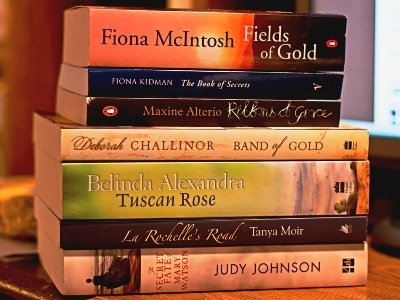
The books look even more appealing when you see the covers, so here they are below.
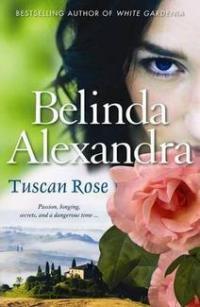
This is a huge trade paperback, 550pp long. Belinda Alexandra is an Australian historical novelist who has set her novels all over the world. I'd call them romantic epics. Tuscan Rose centers on a young woman living in Florence, Italy, in the 1930s and '40s, who is compelled to uncover her true identity at a time when Fascism takes hold of her country. HarperCollins Australia, 2010.
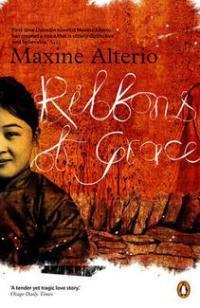
An unlikely love story unfolds in the gold rush settlement of Arrowtown in 19th-century New Zealand, as a young Chinese woman named Ming Yuet disguises herself as a miner. Penguin New Zealand, 2008.
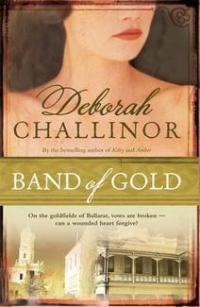
This is another gold rush-era romantic story set in Old Ballarat, a mining boomtown near Melbourne. I won't reveal more of the storyline, because this is 3rd in a series after Kitty and Amber, tales of strong women during the early days of Australia and New Zealand. HarperCollins New Zealand, 2010.
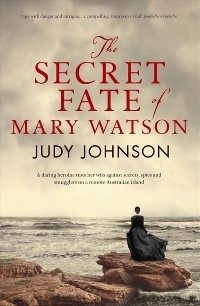
I just love this cover design. The tagline says: "A daring heroine tests her wits against secrets, spies, and smugglers on a remote Australian island." Mary Watson was a real person from 1879 Queensland, an adventure-seeking woman who left behind a few brief diary entries hinting at her fate. This literary fiction novel picks up where those fragments leave off. 4th Estate, 2011.
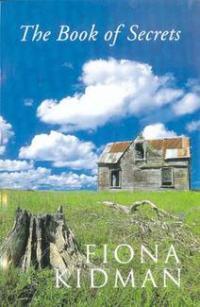
This compact little novel (311pp but dense in terms of weight) tells the historically-based story of the migrations from Nova Scotia to Australia in 1817, and the colony's subsequent settlement in New Zealand in 1854, under the leadership of Norman McLeod. Kidman tells the story from the viewpoint of three generations of women, whose stories date from 1812 to 1953. Vintage New Zealand, 1988.
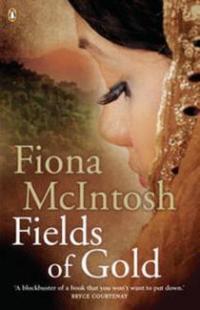
This is one of the most gorgeous covers I've seen anywhere, and it's on a book I'd been looking to buy for over a year. Fiona McIntosh is best known as a fantasy writer, and this is her first installment of a family saga based on her the history of her ancestors. It begins at the end of the Great War. "From the windswept clifftops of the Cornish coast to the goldmines of southern India, this is a page turning story of high adventure, devastating tragedy and enduring love." Penguin Australia, this edition 2011.
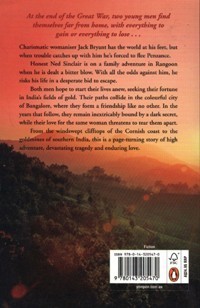
And here is the back cover, which is just as spectacular.
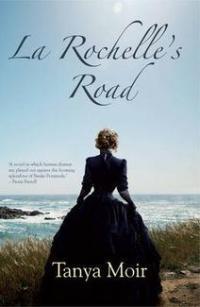
I first read about La Rochelle's Road at Cat's blog Tell Me a Story; she's a NZ blogger who specializes in historical fiction. In 1866, Hester Peterson discovers the journal of a past resident of her family's home - Etienne La Rochelle, who caused a scandal by taking a Maori lover. What she learns sets her on a dangerous path of beauty, darkness, and illicit love. Black Swan (NZ), 2011.
Now which one should I read first?
A couple of these were actually recent purchases from Bookcloseouts, but they fit the subject and I figured I'd add them to the pile.

The books look even more appealing when you see the covers, so here they are below.

This is a huge trade paperback, 550pp long. Belinda Alexandra is an Australian historical novelist who has set her novels all over the world. I'd call them romantic epics. Tuscan Rose centers on a young woman living in Florence, Italy, in the 1930s and '40s, who is compelled to uncover her true identity at a time when Fascism takes hold of her country. HarperCollins Australia, 2010.

An unlikely love story unfolds in the gold rush settlement of Arrowtown in 19th-century New Zealand, as a young Chinese woman named Ming Yuet disguises herself as a miner. Penguin New Zealand, 2008.

This is another gold rush-era romantic story set in Old Ballarat, a mining boomtown near Melbourne. I won't reveal more of the storyline, because this is 3rd in a series after Kitty and Amber, tales of strong women during the early days of Australia and New Zealand. HarperCollins New Zealand, 2010.

I just love this cover design. The tagline says: "A daring heroine tests her wits against secrets, spies, and smugglers on a remote Australian island." Mary Watson was a real person from 1879 Queensland, an adventure-seeking woman who left behind a few brief diary entries hinting at her fate. This literary fiction novel picks up where those fragments leave off. 4th Estate, 2011.

This compact little novel (311pp but dense in terms of weight) tells the historically-based story of the migrations from Nova Scotia to Australia in 1817, and the colony's subsequent settlement in New Zealand in 1854, under the leadership of Norman McLeod. Kidman tells the story from the viewpoint of three generations of women, whose stories date from 1812 to 1953. Vintage New Zealand, 1988.

This is one of the most gorgeous covers I've seen anywhere, and it's on a book I'd been looking to buy for over a year. Fiona McIntosh is best known as a fantasy writer, and this is her first installment of a family saga based on her the history of her ancestors. It begins at the end of the Great War. "From the windswept clifftops of the Cornish coast to the goldmines of southern India, this is a page turning story of high adventure, devastating tragedy and enduring love." Penguin Australia, this edition 2011.

And here is the back cover, which is just as spectacular.

I first read about La Rochelle's Road at Cat's blog Tell Me a Story; she's a NZ blogger who specializes in historical fiction. In 1866, Hester Peterson discovers the journal of a past resident of her family's home - Etienne La Rochelle, who caused a scandal by taking a Maori lover. What she learns sets her on a dangerous path of beauty, darkness, and illicit love. Black Swan (NZ), 2011.
Now which one should I read first?
Published on September 12, 2011 19:00
September 11, 2011
A look at Elle Newmark's The Sandalwood Tree
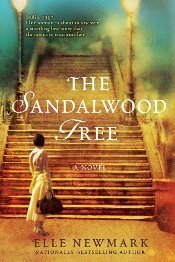 Elle Newmark's The Sandalwood Tree is an engrossing novel set during two pivotal periods in the history of colonial India.
Elle Newmark's The Sandalwood Tree is an engrossing novel set during two pivotal periods in the history of colonial India.Evie Mitchell arrives in India in 1947 with her historian husband, Martin, and their five-year-old son, Billy. The recipient of a Fulbright Fellowship, Martin is eager to document firsthand the last days of the British Raj. Evie hopes that their staying together as a family in this unfamiliar land will repair their strained marriage and teach Billy about respecting other countries' beliefs.
Things don't turn out as she planned. Martin refuses to discuss his wartime experiences with Evie and, with the timeline for India's Partition moved up unexpectedly, worries about their safety. Evie doesn't fit in with the bigoted expatriate community and is left to her own devices. Tired of what she feels is Martin's paranoia, she feels lonely and restless.
Then, concealed within their bungalow in the village of Masoorla, just outside Simla, Evie discovers fragments of personal letters between Felicity and Adele, two Victorian-era friends who lived in her house 90 years before. She gets caught up in their lives and determines to find out what happened to them. Their story, a tale of daring female adventure and several instances of forbidden love, is revealed piece by piece and intertwines neatly with Evie's narrative.
Newmark's vibrant portrait of India details its opulent beauty, its appalling poverty, and the difficult paths to cross-cultural understanding. The tension level rises as the relaxing atmosphere of remote Masoorla braces up against the violent Muslim-Hindu conflicts before Partition in the later timeline, and the tragic aftermath of the Sepoy Mutiny in the earlier one.
This isn't the type of historical novel that glorifies unconventional behavior during a restrictive time. It's more realistic than that. Both Felicity and Adele flout their families' expectations, each choosing personal happiness over society's approval. As she learns more about them, Evie comes to admire them as trailblazers, but they're considered scandalous by their contemporaries.
I read The Sandalwood Tree in just over a day, immersed in the Indian setting and the dilemmas faced by all three women. Sadly, the quote at the very beginning of the novel, Adele's remark that "death steals everything but our stories," could be the author's epitaph. She passed away in June after a two-year illness. Newmark became a successful author late in life, and her journey from aspiring writer to self-published novelist to international bestseller is truly inspiring.
The Sandalwood Tree was published by Atria in April at $25.99 ($29.99 in Canada) and by Black Swan (UK) in August at £7.99.
Published on September 11, 2011 17:40
September 10, 2011
The Borgia Betrayal contest winner
I'll be posting more later today or tomorrow, but for now -- I've just drawn the winner of Sara Poole's The Borgia Betrayal, with the help of Random.org. Congrats to Sam from Tiny Library! Looks like this copy will be winging its way over to the UK soon.
In her comment, Sam wrote that she's my newest follower (thanks for reading the site!). After reading her recent review of Elle Newmark's The Sandalwood Tree , I decided to pick it up next. The review copy's been on my pile for a few months, and it looked like a good book to lose myself in after a very busy work week.
In her comment, Sam wrote that she's my newest follower (thanks for reading the site!). After reading her recent review of Elle Newmark's The Sandalwood Tree , I decided to pick it up next. The review copy's been on my pile for a few months, and it looked like a good book to lose myself in after a very busy work week.
Published on September 10, 2011 07:22
September 5, 2011
Book review: Deborah Lawrenson's The Lantern
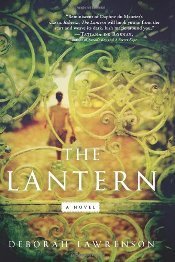 In her modern Gothic mystery, her first novel to be published in America, Deborah Lawrenson plunges readers into the atmosphere of rural Provence, a place both entrancing and chilling.
In her modern Gothic mystery, her first novel to be published in America, Deborah Lawrenson plunges readers into the atmosphere of rural Provence, a place both entrancing and chilling.When Eve, a young freelance translator, meets Dom, an older musician, at a chateau along Lake Geneva, both are at low points in their lives. They unexpectedly fall in love, and together they purchase a huge, crumbling farmhouse, Les Génevriers, nestled in the Luberon Mountains of southern France. Here they delight in the pleasures of the region and in each other, but as the seasons change, shadows appear in their relationship. Dom refuses to speak about his former wife, Rachel, and withdraws more and more into himself. His coldness arouses Eve's curiosity and alarm and incites her to search for answers.
In alternating chapters that don't mark the change of narrator (but which aren't confusing for the switch), an elderly woman named Bénédicte Lincel speaks of growing up at Les Génevriers in the 1930s and 40s. Her glorious childhood is marred only by the cruelty of her older brother, Pierre, and her family's decline into poverty during the postwar years. Both Eve and Bénédicte catch glimpses of what they believe are ghosts on the property, and apprehension builds as the tragedies in their lives are slowly uncovered.
Reflecting the bounty of the land, the language is ripe and sensual (tomatoes are "as ribbed and plump as harem cushions"). The regional specialties, like vin de noix – sweet walnut liqueur – sound mouth-wateringly delicious. Armchair travelers will revel in Lawrenson's lush descriptions of the lavender harvest, an event in which Bénédicte participates in order to share the experience with her blind sister, Marthe, who grows up to be a renowned parfumeuse. The cycle of life is evoked in full, from birth and growth through death and decay – as it affects local crops, the structure of Les Génevriers, and the affairs of its human inhabitants.
The Lantern is setting-driven before it becomes character-driven, as if to imply that one must get to know the terrain before knowing its people. Everyone is holding something back, and Eve herself acknowledges the uncanny similarities between her life and the plot of Rebecca. To enhance the parallels even more, "Eve" is merely Dom's nickname for the modern narrator; her real name is never given.
A few scenes cheapen the reading experience. Pierre is a stereotypical bully, and his malicious actions are foreshadowed from miles away. But apart from this, the author displays smart plotting and a good sense of timing. She gently manipulates readers along a suspenseful path, culminating in an astonishing revelation that Du Maurier couldn't have imagined.
Those who enjoy Kate Morton's novels and other Gothic family sagas should enjoy this book as well, although its pacing is more drawn out in the beginning, and its phrasings have more of a literary flair. Darkly evocative, beautifully written, and overflowing with the sights and scents of the Provençal countryside, The Lantern takes a powerful look at the haunting presence of the past.
The Lantern was published by Harper in September at $25.99 (hardcover, 384pp). In the UK, it's available from Orion in either hardcover (£18.99) or paperback (£7.99), with a very similar cover.
Published on September 05, 2011 11:58
August 31, 2011
Book review and giveaway: Sara Poole's The Borgia Betrayal
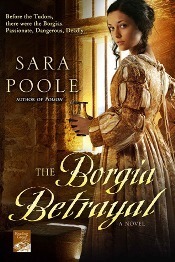 Sara Poole's historical thriller The Borgia Betrayal begins with a poisoning, not an uncommon occurrence during the deadly power games of the Italian Renaissance, but two things set it apart. First, the perpetrator is a woman, Pope Alexander VI's court poisoner Francesca Giordano, and she seems – almost – to have compassion for the poor fellow who dies. Keeping her boss safe is her mission, and she'll do what she has to.
Sara Poole's historical thriller The Borgia Betrayal begins with a poisoning, not an uncommon occurrence during the deadly power games of the Italian Renaissance, but two things set it apart. First, the perpetrator is a woman, Pope Alexander VI's court poisoner Francesca Giordano, and she seems – almost – to have compassion for the poor fellow who dies. Keeping her boss safe is her mission, and she'll do what she has to.For her newest assignment, Francesca must find a discreet way of killing off Cardinal della Rovere, the Borgia pope's main rival. The story is hastened forward by several subplots that seem, at first, to be distractions from the main event.
While Borgia fights to keep Spain as a firm ally against the unruly French, Spain pressures him to break off his daughter Lucrezia's betrothal to Giovanni Sforza of Milan and to banish the Jews from Rome. He doesn't plan to do either. Rumors are spreading about the impending arrival of the fanatical monk from Florence, Savonarola. Amid the political tumult, Francesca refuses to abandon her personal quest: killing the mad priest, Bernando Morozzi, who masterminded her father's death.
Francesca fancies herself an outcast, an unnatural woman who enjoys her job a little too much and doesn't want the darkness inside her to touch anyone else. Although it's true that most people around the Vatican fear her (for good reason), she has more friends than she thinks. Among them are the handsome glassmaker she won't let herself get close to; her fellow members of the Lux, a secret society of free-thinkers; and her lover Cesare Borgia, the pope's son, whose lusts and dark leanings match her own.
Poole's depiction of Cesare is refreshing and suitably complex. Just seventeen in the year 1493, Cesare is more than just a power-hungry, immoral adolescent. He truly cares for Francesca, and their developing relationship – as well as his with his father – will be worth watching in future books.
Francesca's first-person voice has a sarcastic directness that comes as a nice change in an era where one's feelings are best kept hidden. Despite the many tangled strands of the plot, the narrative speeds along smoothly, and the author displays an intimate familiarity with this dangerous time and place. The Borgia Betrayal is second in a series after Poison. It works well as a standalone, although there are enough intriguing references to events from the first book for newcomers to regret not having read it.
The Borgia Betrayal was published by St. Martin's Griffin in June at $14.99 ($16.99 in Canada) in trade paperback (389pp, plus bonus material including an author interview, historical essay, and timeline).
Interested in winning a copy for yourself? I have one up for grabs. To enter, leave a comment on this post. Deadline Friday, September 9th. This contest is open internationally. Good luck!
Published on August 31, 2011 09:00
August 29, 2011
Bits and pieces
Thanks to whoever chose to nominate this site for "best historical fiction blog" in the Book Blogger Appreciation Week annual awards. It's much appreciated, and congrats to my fellow nominees. If anyone's curious, here are the posts I selected for the judging. At least I think they're what I put down. The fall semester started a week ago and I'm lucky I know which way is up.
X is for Xenia, my review of Jane Alison's The Love-Artist.
Daughters of Summer, a visual preview of summer 2011 books that shows a popular title trend...
My review of Carol K. Carr's India Black, which was as fun to write as the book was to read.
The interview I conducted with Sonia Gensler about her spooky ghost story The Revenant.
My compilation of historical fiction picks at BEA 2011. I've read just one of these so far, Stella Tillyard's Tides of War, which was a Booklist review assignment.
In other news, I established a new Facebook page for the blog, so please join me there if you're able: http://www.facebook.com/readingthepastblog
And for some historical novel deals, from Publishers Marketplace's Lunch Deluxe reports:
Linda Holeman's untitled book, pitched as 'Anna Karenina meets Downton Abbey', and set in 1861 Imperialist Russia in the aftermath of the Emancipation of the Serfs, a sweeping tale of how the political turmoil of the country affects one landowner's family, to Anne Collins at Random House Canada, in a very nice deal, in a two-book deal, for publication in spring 2012, by Sarah Heller at the Helen Heller Agency. [and I'd actually gone looking to her website when putting together my Canadian preview to see if she had a new book coming out - ask and ye shall receive]
Stephanie Dray's DAUGHTER OF THE NILE, the final book in the author's trilogy tracing the ambitious and passionate life of Selene -- daughter of Cleopatra, princess of Egypt, Queen of Mauretania, and disciple of Isis, to Cindy Hwang at Berkley, by Jennifer Schober at Spencerhill Associates (NA). [I'll be reading this; here's my review of book one.]
Carlene Bauer's FRANCES & BERNARD, an epistolary novel imagining the friendship, discussions of faith and art, and bittersweet romance between two writers in late 1950s New York, inspired by Flannery O'Connor and Robert Lowell, to Jenna Johnson at Houghton Mifflin Harcourt, in a pre-empt, for publication in Fall 2012, by PJ Mark at Janklow & Nesbit (World English).
Author of WILDFLOWER HILL Kimberley Freeman's ISABELLA'S GIFT, spanning centuries about two women connected by a secret hidden in the walls of a family lighthouse, to Sally Kim for Touchstone, for publication in summer 2012, by Airlie Lawson at Hachette Australia.
Christine Wade's THE BOWER WIFE, a retelling of the first American folk tale in which a woman's husband mysteriously vanishes, abandoning her and her children on their farm at the foot of the Catskills, and a dark story begins to circulate in the small frontier community near which the family lives, as the Revolutionary War fast approaches, to Sarah Durand at Atria, by Eleanor Jackson at Markson Thoma (World). [folk tale about the early Revolutionary period? I'm there]
The Darling Strumpet and The September Queen author Gillian Bagwell's MY LADY BESS, based on the life of Bess of Hardwick, 1527-1608, the formidable four-times widowed Tudor dynasty who began life in genteel poverty and ended as the richest and most powerful woman in England after Queen Elizabeth; built Chatsworth House and Hardwick Hall; and is the forebear of numerous noble lines including the current royal family of Britain, to Kate Seaver at Berkley, by Kevan Lyon at Marsal Lyon Literary Agency (NA). [about time for a new fictional retelling of Bess of Hardwick's life!]
X is for Xenia, my review of Jane Alison's The Love-Artist.
Daughters of Summer, a visual preview of summer 2011 books that shows a popular title trend...
My review of Carol K. Carr's India Black, which was as fun to write as the book was to read.
The interview I conducted with Sonia Gensler about her spooky ghost story The Revenant.
My compilation of historical fiction picks at BEA 2011. I've read just one of these so far, Stella Tillyard's Tides of War, which was a Booklist review assignment.
In other news, I established a new Facebook page for the blog, so please join me there if you're able: http://www.facebook.com/readingthepastblog
And for some historical novel deals, from Publishers Marketplace's Lunch Deluxe reports:
Linda Holeman's untitled book, pitched as 'Anna Karenina meets Downton Abbey', and set in 1861 Imperialist Russia in the aftermath of the Emancipation of the Serfs, a sweeping tale of how the political turmoil of the country affects one landowner's family, to Anne Collins at Random House Canada, in a very nice deal, in a two-book deal, for publication in spring 2012, by Sarah Heller at the Helen Heller Agency. [and I'd actually gone looking to her website when putting together my Canadian preview to see if she had a new book coming out - ask and ye shall receive]
Stephanie Dray's DAUGHTER OF THE NILE, the final book in the author's trilogy tracing the ambitious and passionate life of Selene -- daughter of Cleopatra, princess of Egypt, Queen of Mauretania, and disciple of Isis, to Cindy Hwang at Berkley, by Jennifer Schober at Spencerhill Associates (NA). [I'll be reading this; here's my review of book one.]
Carlene Bauer's FRANCES & BERNARD, an epistolary novel imagining the friendship, discussions of faith and art, and bittersweet romance between two writers in late 1950s New York, inspired by Flannery O'Connor and Robert Lowell, to Jenna Johnson at Houghton Mifflin Harcourt, in a pre-empt, for publication in Fall 2012, by PJ Mark at Janklow & Nesbit (World English).
Author of WILDFLOWER HILL Kimberley Freeman's ISABELLA'S GIFT, spanning centuries about two women connected by a secret hidden in the walls of a family lighthouse, to Sally Kim for Touchstone, for publication in summer 2012, by Airlie Lawson at Hachette Australia.
Christine Wade's THE BOWER WIFE, a retelling of the first American folk tale in which a woman's husband mysteriously vanishes, abandoning her and her children on their farm at the foot of the Catskills, and a dark story begins to circulate in the small frontier community near which the family lives, as the Revolutionary War fast approaches, to Sarah Durand at Atria, by Eleanor Jackson at Markson Thoma (World). [folk tale about the early Revolutionary period? I'm there]
The Darling Strumpet and The September Queen author Gillian Bagwell's MY LADY BESS, based on the life of Bess of Hardwick, 1527-1608, the formidable four-times widowed Tudor dynasty who began life in genteel poverty and ended as the richest and most powerful woman in England after Queen Elizabeth; built Chatsworth House and Hardwick Hall; and is the forebear of numerous noble lines including the current royal family of Britain, to Kate Seaver at Berkley, by Kevan Lyon at Marsal Lyon Literary Agency (NA). [about time for a new fictional retelling of Bess of Hardwick's life!]
Published on August 29, 2011 19:18
August 27, 2011
A Canadian historical fiction showcase, part 2
I've been getting a lot of visitors to my first visual preview of Canadian historical fiction so decided to do a followup. Most of these historical novels will be appearing in fall 2011.
In addition, no cover art is available for this one yet, so I haven't listed it below, but I wanted to make a special note of one book I'm highly anticipating. Michael Ennis (author of the fabulous Duchess of Milan) will have a new novel out in late January from McClelland & Stewart. A Most Beautiful Deception is a fact-based historical thriller set in the world of Niccolò Machiavelli and Leonardo da Vinci. Ennis isn't Canadian, but the novel doesn't appear to be published elsewhere.
Happy browsing. Did I miss any important titles? Let me know!
[image error]
In a series of connected short stories spanning 1901 to 1999, DeGrace takes readers through a century of change in the company of a large cast of characters. The setting moves through the vast Canadian landscape, from early 20th-century Ontario to 1920s Montreal to Depression-era Saskatchewan and beyond. McArthur & Co., Sept.
[image error]
The story of Molly Norton, the half-native daughter of the governor of Hudson's Bay Company in 18th-century Manitoba, and Samuel Hearne, the explorer she married. A sensitive rendering of a tragic clash of cultures that took place over two centuries ago. The characters are based on historical figures. HarperCollins Canada, March (it's already out, and my copy arrived in yesterday's mail).
[image error]
The love triangle between novelist Victor Hugo; Hugo's long-suffering wife, Adèle; and Hugo's would-be friend, French journalist and literary critic Charles Sainte-Beuve, set during the reign of Napoleon III. HarperCollins Canada, Sept.; published in the UK in July by Serpent's Tail.
[image error]
Maureen Jennings' Detective Murdoch mysteries set in late 19th-century Toronto are hugely popular in Canada. Season of Darkness, first in her new series, takes place in rural Shropshire a year into WWII. A detective who expected to be bored by his seemingly dull assignment finds himself investigating the death of a land girl. Read the review from the NY Times. McClelland & Stewart, Aug.
[image error]
Another of Johnston's literary epics, this time set in late 19th-century Newfoundland, New Jersey, and North Carolina. When his personal circumstances turn sour, a man turns to his wealthy former Princeton classmate, George "Van" Vanderluyden, for help, and gets drawn into his deceitful net. (Van is based on George Washington Vanderbilt II, who constructed Biltmore.) Knopf Canada, Aug.
[image error]
It's been four years since McKay's debut, The Birth House, her celebrated and bestselling novel about the trials of a determined young midwife in an early 20th-century Nova Scotia fishing village. Expect plenty of demand for The Virgin Cure, which was inspired by her great-great-grandmother's story. Moth grows up in the slums of New York's Bowery district, where she befriends a female physician and become wise to the cruel ways of the adult world. Knopf Canada, Oct; to be pub by HarperCollins US in Feb 2012.
[image error]
The Forgetful Shore by Newfoundlander Trudy Morgan-Cole reveals the stories of two friends, closer than sisters, who grow up in a small coastal town in the early 20th century. Although they remain in touch after their adult lives diverge, their friendship abruptly changes when a long-held secret emerges. The author has also written novels about biblical women as well as The Violent Friendship of Esther Johnson, about a shadowy woman who was Jonathan Swift's good friend and possibly more. Breakwater, Sept.
[image error]
Gayla Reid is a multi-award winning Australian-Canadian writer, and her latest work incorporates elements from the history of both countries. It tells the story of an Australian nurse longing for news of her Canadian lover, a volunteer on the Republican side of the Spanish Civil War. While she waits, she reveals her life story to her daughter. Cormorant, Aug.
[image error]
Polish-Canadian writer Stachniak's third work of fiction is an epic historical novel about Catherine the Great's rise to power in mid-18th century Russia, as seen from the viewpoint of her servant, Varvara. The US publisher is gearing up for promotion already (my copy arrived last week) and I'm sure we'll be seeing much more of it this winter. Let's hope this means Russian settings are on the upswing. Doubleday Canada, Dec; also Bantam US, January, and Doubleday UK, January.
[image error]
Vanderhaeghe, an author of significance in modern Canadian literature, presents his 3rd epic of the American and Canadian West in the late 19th century. The first two books in this loosely formed trilogy are The Englishman's Boy and The Last Crossing. McClelland & Stewart, Sept., and Atlantic Monthly (US), Jan.
[image error]
In 1788, Lt. George Cartwright's trading expedition set out to make peaceful contact with the Beothuk, the native inhabitants of Newfoundland, in 1768. Literary historical adventure along the early Canadian frontier. Breakwater, Sept.
In addition, no cover art is available for this one yet, so I haven't listed it below, but I wanted to make a special note of one book I'm highly anticipating. Michael Ennis (author of the fabulous Duchess of Milan) will have a new novel out in late January from McClelland & Stewart. A Most Beautiful Deception is a fact-based historical thriller set in the world of Niccolò Machiavelli and Leonardo da Vinci. Ennis isn't Canadian, but the novel doesn't appear to be published elsewhere.
Happy browsing. Did I miss any important titles? Let me know!
[image error]
In a series of connected short stories spanning 1901 to 1999, DeGrace takes readers through a century of change in the company of a large cast of characters. The setting moves through the vast Canadian landscape, from early 20th-century Ontario to 1920s Montreal to Depression-era Saskatchewan and beyond. McArthur & Co., Sept.
[image error]
The story of Molly Norton, the half-native daughter of the governor of Hudson's Bay Company in 18th-century Manitoba, and Samuel Hearne, the explorer she married. A sensitive rendering of a tragic clash of cultures that took place over two centuries ago. The characters are based on historical figures. HarperCollins Canada, March (it's already out, and my copy arrived in yesterday's mail).
[image error]
The love triangle between novelist Victor Hugo; Hugo's long-suffering wife, Adèle; and Hugo's would-be friend, French journalist and literary critic Charles Sainte-Beuve, set during the reign of Napoleon III. HarperCollins Canada, Sept.; published in the UK in July by Serpent's Tail.
[image error]
Maureen Jennings' Detective Murdoch mysteries set in late 19th-century Toronto are hugely popular in Canada. Season of Darkness, first in her new series, takes place in rural Shropshire a year into WWII. A detective who expected to be bored by his seemingly dull assignment finds himself investigating the death of a land girl. Read the review from the NY Times. McClelland & Stewart, Aug.
[image error]
Another of Johnston's literary epics, this time set in late 19th-century Newfoundland, New Jersey, and North Carolina. When his personal circumstances turn sour, a man turns to his wealthy former Princeton classmate, George "Van" Vanderluyden, for help, and gets drawn into his deceitful net. (Van is based on George Washington Vanderbilt II, who constructed Biltmore.) Knopf Canada, Aug.
[image error]
It's been four years since McKay's debut, The Birth House, her celebrated and bestselling novel about the trials of a determined young midwife in an early 20th-century Nova Scotia fishing village. Expect plenty of demand for The Virgin Cure, which was inspired by her great-great-grandmother's story. Moth grows up in the slums of New York's Bowery district, where she befriends a female physician and become wise to the cruel ways of the adult world. Knopf Canada, Oct; to be pub by HarperCollins US in Feb 2012.
[image error]
The Forgetful Shore by Newfoundlander Trudy Morgan-Cole reveals the stories of two friends, closer than sisters, who grow up in a small coastal town in the early 20th century. Although they remain in touch after their adult lives diverge, their friendship abruptly changes when a long-held secret emerges. The author has also written novels about biblical women as well as The Violent Friendship of Esther Johnson, about a shadowy woman who was Jonathan Swift's good friend and possibly more. Breakwater, Sept.
[image error]
Gayla Reid is a multi-award winning Australian-Canadian writer, and her latest work incorporates elements from the history of both countries. It tells the story of an Australian nurse longing for news of her Canadian lover, a volunteer on the Republican side of the Spanish Civil War. While she waits, she reveals her life story to her daughter. Cormorant, Aug.
[image error]
Polish-Canadian writer Stachniak's third work of fiction is an epic historical novel about Catherine the Great's rise to power in mid-18th century Russia, as seen from the viewpoint of her servant, Varvara. The US publisher is gearing up for promotion already (my copy arrived last week) and I'm sure we'll be seeing much more of it this winter. Let's hope this means Russian settings are on the upswing. Doubleday Canada, Dec; also Bantam US, January, and Doubleday UK, January.
[image error]
Vanderhaeghe, an author of significance in modern Canadian literature, presents his 3rd epic of the American and Canadian West in the late 19th century. The first two books in this loosely formed trilogy are The Englishman's Boy and The Last Crossing. McClelland & Stewart, Sept., and Atlantic Monthly (US), Jan.
[image error]
In 1788, Lt. George Cartwright's trading expedition set out to make peaceful contact with the Beothuk, the native inhabitants of Newfoundland, in 1768. Literary historical adventure along the early Canadian frontier. Breakwater, Sept.
Published on August 27, 2011 17:00
August 22, 2011
A look at Karleen Koen's Before Versailles
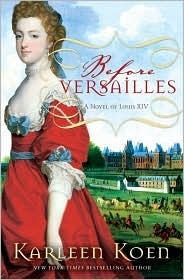 Karleen Koen's lush and literary fourth novel takes place over the six-month period, March through September 1661, when Louis XIV of France transformed himself into an absolute monarch. Reading it provides complete immersion into the elaborate rituals and gorgeous décor at the French royal court. While the atmosphere at the Château de Fontainebleau may seem light and carefree on the surface, however, cruel power games play out behind the scenes.
Karleen Koen's lush and literary fourth novel takes place over the six-month period, March through September 1661, when Louis XIV of France transformed himself into an absolute monarch. Reading it provides complete immersion into the elaborate rituals and gorgeous décor at the French royal court. While the atmosphere at the Château de Fontainebleau may seem light and carefree on the surface, however, cruel power games play out behind the scenes.France's greatest administrator, Cardinal Mazarin, has just died, and rival statesmen are moving in to fill the void. With the country's recent civil wars (the Fronde) never far from his mind, 22-year-old King Louis must decide who pledges their true loyalty and who intrigues against him. The omniscient viewpoint ensures a comprehensive portrait of the place and time. Readers get to see the inner thoughts and motives of all the major players, from the worries and ambitions of the queen mother, Anne of Austria, to the lusty schemes of Catherine, Princess of Monaco, all without losing sight of the larger story.
As Louis solidifies his grip on the reins of power, he begins to understand that some choices simply aren't open to him. Even a king can't have everything he wants, especially if one of them is Henriette, his younger brother Philippe's fun-loving and flirtatious wife. Fortunately, before the court erupts in scandal over their forbidden love affair, his eye turns to someone new.
Louise de la Baume le Blanc is a kind, gentle, and shy maid of honor, and in a court full of hidden agendas, Louis appreciates a woman who won't play him false. Their connection is deep and passionate, and, as Koen alludes, on his side it will be temporary – but it feels no less poignant for that. Louise also has a curious streak. One day while out riding in the woods, she spies a boy wearing an iron mask, not realizing her quest to discover his secret has the potential to shake the kingdom.
With its richly decadent setting, Before Versailles is a dazzling feast for the visual imagination. The abundance of detail can be too much to take in all at once (you wouldn't expect to see all of Fontainebleau in a single day, would you?) so prepare for a leisurely read. In addition, the novel is a skilled evocation of one man's determination to take control of the land he was born to rule.
Before Versailles was published by Crown in late June at $26.00 / $31 in Canada (hardcover, 460pp).
Published on August 22, 2011 07:00
August 18, 2011
Guest post from Elisabeth Storrs: Snail Mail, Rome and Ursula Le Guin
I'm so pleased to present this guest post from Elisabeth Storrs, whose excellent historical novel of ancient Etruria, The Wedding Shroud, I reviewed last December. While the paperback version is currently available only in Australia, it's newly out in ebook format worldwide and can be purchased on Amazon, iBookstore and Kobo. Visit her website for links.
Elisabeth's post will be of interest to writers as well as readers. How does a debut novelist approach a well-known author for an endorsement? Please read on!
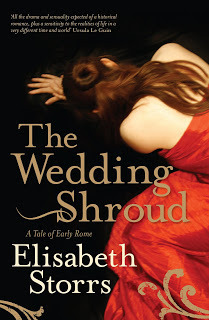 Snail Mail, Rome and Ursula Le Guin
Snail Mail, Rome and Ursula Le Guin
Old fashioned courtesy can go a long way. And so, too, can snail mail. When I requested Ursula Le Guin to endorse my novel I used both.
Last year my first novel, The Wedding Shroud, was published in Australia (and has now been released as an e-book world wide). The book is set in C5th BCE at a time when Rome was still scrapping for ascendancy over its Latin neighbours. The book compares the intolerant insular Romans with its enemies, the Etruscans, a people whose highly sophisticated civilisation spread throughout Italy and across the Mediterranean into northern Europe. My protagonist is a young Roman girl married to an Etruscan nobleman to seal a truce. Leaving behind a righteous society, she is determined to remain true to Roman virtues while living among the sinful Etruscans. Instead she finds herself tempted by a mystical, hedonistic culture which offers pleasure and independence to women.
As an unknown writer I faced the daunting task of gaining publicity and credibility amid a plethora of new releases in the market place. My publisher suggested I have the book endorsed by a well known author. Sounded like a great idea. Only problem was to find one who would do it!
My immediate thought was to find an historical fiction author whom I admired. There was no lack of these. I also thought it would be best if I could identify someone who was interested in the subject matter of my novel not just in history per se.
Around this time, a friend of mine mentioned that Ursula Le Guin's Lavinia had been released to rave reviews. I was fascinated by this as I only knew her as the eminent author of amazing fantasy novels. I was also intrigued by the title of her book as I recognised it as the name of the wife of Aeneas, the hero of The Aeneid, an epic written by the Roman poet Vergil.
I read Lavinia and was transported back to a time when Rome was yet to be founded and a war weary Trojan wanderer fell in love with the daughter of Latium's king. The character of Lavinia is not developed in The Aeneid but Ursula Le Guin created a complex woman whose love for a stranger started a war.
As a school girl I loved translating The Aeneid and it struck me that Ursula Le Guin must have a similar affection. In her Author's Note I read how she had visited the area in Italy where ancient Latium was situated. Her delight in walking the same land upon which her characters had dwelt was clear. Her enthusiasm resonated with me. I also had dreams of standing in the ruins of Veii, the Etruscan city in which my novel is set.
I looked at Ursula Le Guin's website and found that she was prepared to write blurbs for books but would only respond to letters i.e. snail mail. With a gentle sense of humour she also specified that overseas correspondents should include an international reply coupon if they expected a response due to the fact she would have to bear the costs of mailing a reply. As she personally answered her own correspondence this could take some time. In her own words 'Silence means I'm sorry: Art is long, life is short, and I want to get on with my own book.'
On the premise of 'she can only say no' or more to the point - reply with silence, I wrote her a letter. In it I explained how much I enjoyed Lavinia because of my fondness for Vergil's The Aeneid. I also provided a one page synopsis of my novel and explained how I, too, wished to walk upon ancient land in reality as well as in my imagination.
I have a vivid memory of hurrying to my local post office and asking for an international reply coupon before slipping the letter into the big red mailbox and crossing my fingers. To my utter astonishment, she responded only a few weeks later to say that she had always been fascinated by the Etruscans and would like to visit ancient Veii through reading my book. Imagine my excitement when she then agreed to endorse it! I still find it hard to believe she was gracious enough to reply let alone write a blurb.
Only Ursula Le Guin can tell why she was prepared to give her time and endorsement to an unknown Australian writer but in the end I believe that, in this world of Twitter, Facebook and email, the old fashioned courtesy of taking time to write and post a letter with a self addressed envelope and a reply coupon must have helped. It was also fate, too, because not longer after this Australia Post phased out international reply coupons. So maybe the Etruscan gods were smiling upon me. I'm certainly glad they did.
~Elisabeth Storrs
Elisabeth Storrs graduated from the University of Sydney in Arts Law, majoring in English and having studied Classics. She lives with her husband and two sons in Sydney and over the years has worked as a solicitor, corporate lawyer, senior manager and company secretary.
Elisabeth's first novel, The Wedding Shroud, is set in early Rome and Etruria, and was researched and written over a period of ten years. It is now available as an ebook world wide. She is currently writing the sequel which will be released by Pier 9 / Murdoch Books in 2012.
Elisabeth's post will be of interest to writers as well as readers. How does a debut novelist approach a well-known author for an endorsement? Please read on!
 Snail Mail, Rome and Ursula Le Guin
Snail Mail, Rome and Ursula Le GuinOld fashioned courtesy can go a long way. And so, too, can snail mail. When I requested Ursula Le Guin to endorse my novel I used both.
Last year my first novel, The Wedding Shroud, was published in Australia (and has now been released as an e-book world wide). The book is set in C5th BCE at a time when Rome was still scrapping for ascendancy over its Latin neighbours. The book compares the intolerant insular Romans with its enemies, the Etruscans, a people whose highly sophisticated civilisation spread throughout Italy and across the Mediterranean into northern Europe. My protagonist is a young Roman girl married to an Etruscan nobleman to seal a truce. Leaving behind a righteous society, she is determined to remain true to Roman virtues while living among the sinful Etruscans. Instead she finds herself tempted by a mystical, hedonistic culture which offers pleasure and independence to women.
As an unknown writer I faced the daunting task of gaining publicity and credibility amid a plethora of new releases in the market place. My publisher suggested I have the book endorsed by a well known author. Sounded like a great idea. Only problem was to find one who would do it!
My immediate thought was to find an historical fiction author whom I admired. There was no lack of these. I also thought it would be best if I could identify someone who was interested in the subject matter of my novel not just in history per se.
Around this time, a friend of mine mentioned that Ursula Le Guin's Lavinia had been released to rave reviews. I was fascinated by this as I only knew her as the eminent author of amazing fantasy novels. I was also intrigued by the title of her book as I recognised it as the name of the wife of Aeneas, the hero of The Aeneid, an epic written by the Roman poet Vergil.
I read Lavinia and was transported back to a time when Rome was yet to be founded and a war weary Trojan wanderer fell in love with the daughter of Latium's king. The character of Lavinia is not developed in The Aeneid but Ursula Le Guin created a complex woman whose love for a stranger started a war.
As a school girl I loved translating The Aeneid and it struck me that Ursula Le Guin must have a similar affection. In her Author's Note I read how she had visited the area in Italy where ancient Latium was situated. Her delight in walking the same land upon which her characters had dwelt was clear. Her enthusiasm resonated with me. I also had dreams of standing in the ruins of Veii, the Etruscan city in which my novel is set.
I looked at Ursula Le Guin's website and found that she was prepared to write blurbs for books but would only respond to letters i.e. snail mail. With a gentle sense of humour she also specified that overseas correspondents should include an international reply coupon if they expected a response due to the fact she would have to bear the costs of mailing a reply. As she personally answered her own correspondence this could take some time. In her own words 'Silence means I'm sorry: Art is long, life is short, and I want to get on with my own book.'
On the premise of 'she can only say no' or more to the point - reply with silence, I wrote her a letter. In it I explained how much I enjoyed Lavinia because of my fondness for Vergil's The Aeneid. I also provided a one page synopsis of my novel and explained how I, too, wished to walk upon ancient land in reality as well as in my imagination.
I have a vivid memory of hurrying to my local post office and asking for an international reply coupon before slipping the letter into the big red mailbox and crossing my fingers. To my utter astonishment, she responded only a few weeks later to say that she had always been fascinated by the Etruscans and would like to visit ancient Veii through reading my book. Imagine my excitement when she then agreed to endorse it! I still find it hard to believe she was gracious enough to reply let alone write a blurb.
Only Ursula Le Guin can tell why she was prepared to give her time and endorsement to an unknown Australian writer but in the end I believe that, in this world of Twitter, Facebook and email, the old fashioned courtesy of taking time to write and post a letter with a self addressed envelope and a reply coupon must have helped. It was also fate, too, because not longer after this Australia Post phased out international reply coupons. So maybe the Etruscan gods were smiling upon me. I'm certainly glad they did.
~Elisabeth Storrs
Elisabeth Storrs graduated from the University of Sydney in Arts Law, majoring in English and having studied Classics. She lives with her husband and two sons in Sydney and over the years has worked as a solicitor, corporate lawyer, senior manager and company secretary.
Elisabeth's first novel, The Wedding Shroud, is set in early Rome and Etruria, and was researched and written over a period of ten years. It is now available as an ebook world wide. She is currently writing the sequel which will be released by Pier 9 / Murdoch Books in 2012.
Published on August 18, 2011 06:00
August 15, 2011
Guest post from Nancy Means Wright: An 18th-century Feminist Takes on an Unfair, Feudal Practice
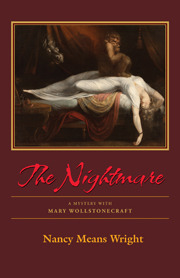 Today author Nancy Means Wright is visiting the blog to discuss the historical practice of primogeniture -- in particular as it figured in the lives of her heroine Mary Wollstonecraft, Mary's contemporaries, and their fictional creations. If you read novels with historical British settings, you'll want to understand the concepts of inheritance law explained in this informative post!
Today author Nancy Means Wright is visiting the blog to discuss the historical practice of primogeniture -- in particular as it figured in the lives of her heroine Mary Wollstonecraft, Mary's contemporaries, and their fictional creations. If you read novels with historical British settings, you'll want to understand the concepts of inheritance law explained in this informative post!------
An 18th-century Feminist Takes on an Unfair, Feudal Practice
by Nancy Means Wright
"Property, " Mary Wollstonecraft wrote in her flaming Vindication of the Rights of Man (1790), "should be fluctuating, which would be the case if it were more equally divided amongst all the children of a family. Else it is an everlasting rampart, in consequence of a barbarous feudal institution that enables the elder son to overpower talents and depress virtue."
The "feudal institution" Mary decried in her rebuttal to the reactionary Edmund Burke, was the law of primogeniture. In practice since the Norman conquest, a father's fortune would go directly to the eldest son, and so on down the male line—the objective being to keep estates intact from generation to generation.
"Security of property: Behold in a few words, the definition of English 'liberty,'" was Mary's ironic reply to Burke, who not only upheld the practice but had attacked Mary's mentor, Unitarian Dr. Richard Price who like Mary, was thrilled with the Liberté, Égalité ideals of the French Revolutionaries.
"To this selfish principle (primogeniture)," she declared, "every nobler one is sacrificed!"
The practice was ensured by means of entail, a legal arrangement under which the father had only an allowance and life interest in the estate, which was then entailed to the eldest son. Any sale of the property was prevented by law, resulting in vast estates owned by extravagantly rich families. By the mid-19th century, one quarter of all British land was held by a mere 701 individuals. Primogeniture, they insisted, was the only way to ensure political and economic stability, and so remained on the law books until 1925!
Mary's grandfather had amassed a small fortune as master silk weaver, but her father squandered it in his attempt to become a gentleman farmer. He failed at every move, and drank away much of the inheritance. Mary's autocratic brother Ned didn't inherit enough money to became a man of leisure, like many elder brothers, but he did practice law, and kept for himself the small legacy assigned to his six siblings. So after her mother's death, elder daughter Mary was left with no money, but all the responsibility for her younger brothers and sisters.
At fourteen, Mary's brother Henry was apprenticed to an apothecary-surgeon, and then disappeared from record. But Mary outfitted James for a naval career, and sent Charles off to make his fortune in America (with middling success). She helped her sister Eliza escape an abusive husband; yet unable to remarry, Eliza had to earn her way as governess. Governessing was the fate of the youngest sister, Everina, as well, and for a time, of Mary herself—"a most humilating occupation!" Her whole short life, Mary sent the little money she earned from her writing to prop up her siblings, along with her feckless father.
No wonder then, that early on, as Virginia Woolf put it, life for Mary became "one cry for justice!" And justice was sorely needed, according to philosopher Francis Bacon, who wrote that tempted by money and power, elder sons were likely to become "disobedient, negligent and wasteful."
Like Mary, 18th-century Nelly Weeton valued family ties and responsibilities, even rejecting an offer of marriage to keep house for her elder brother Tom after their father died at sea. But Tom, who as a boy was close to Nelly, married a woman who wanted no part of the sister. He ultimately stole the little legacy their mother left Nelly, and virtually sold her into servitude. A desperate marriage to a tyrant who appropriated her teaching money, and after a separation, denied her entry to their daughter, turned Nelly's life to abject misery. Mary Wollstonecraft's stepsister, Claire Clairmont, had a similar loss when her indifferent lover, poet Lord Byron, an only son, refused all visits to their daughter, who at eight years of age died alone in a convent.
Although loving and supportive, Jane Austen's elder brother Edward took advantage of the system through the practice of surrogate heirship and its device of name changing, aimed at keeping estates whole. Edward was adopted by a distant cousin, Thomas Knight, and gave up the name of Austen for Knight when he inherited. Biographer David Nokes suggested that Jane felt abandoned by her brother, although Jane's only known comment was: "I must learn to make a better K."
Yet the poison of primogeniture is paramount in Austen's novels. In Pride and Prejudice the Bennet estate is entailed to the pompous Mr. Collins, clergyman cousin to Mr. Bennet who had no sons, leaving the silly Mrs. Bennet, who finds the subject of entail "beyond the reach of reason," to scheme up husbands for her five daughters. Should she fail in the event of her husband's death, mother and daughters would have no home or income. In Northanger Abbey, Austen portrays elder brother Frederick as corrupt and cruel, while in Mansfield Park elder Tom is everyone's party boy. Austen questions the validity of primogeniture when she makes younger brother Edmund the good son, although the latter loses the young woman he loves because he isn't rich enough and is destined to become a boring (to her) clergyman. Happily, in the long run, he discovers he's better off without her.
The disparity of riches between elder and younger brothers was huge, often creating a wide rift between siblings. In a lecture on Shakespeare's King Lear, Samuel Coleridge notes "the mournful alienation of brotherly love…in children of the same stock." 19th century Anthony Trollope's novels are full of younger sons pursuing heiresses, or simply seeking a comfortable bachelorhood without an expensive wife—whereas the elder son must marry in order to produce an heir—think Henry the Eighth!
But considering the fates of Henry's wives, it was females who were the true victims. For most females there was little money or opportunity to find a suitable husband; some indigent ladies found a taboo against marrying beneath them and remained spinsters. But the main drawback, as Mary Wollstonecraft makes clear in her A Vindication of the Rights of Woman, was failure to receive an equal education. A lack of proper schooling, she allowed, often contributed to a pampered indolence in females, and "a false regard for wealth and status over reason and true moral values." In her own life, her mother indulged her first born son, neglecting Mary, though it was Mary, not Ned, who lay nights in front of her mother's bedchamber to waylay the drunken husband.
No doubt Mary was, in part, vindicating the abuses of her own life in her rebuttal to conservative Edmund Burke who considered primogeniture an anchor of social order, but she had known the "demon of property…to encroach on the sacred rights" of legions of unhappy men and women.
"I glow," she cried, "with indignation!"
------
Nancy Means Wright's latest novel is The Nightmare: a Mystery with Mary Wollstonecraft (Perseverance Press, September, '11). www.nancymeanswright.com
Published on August 15, 2011 04:00



